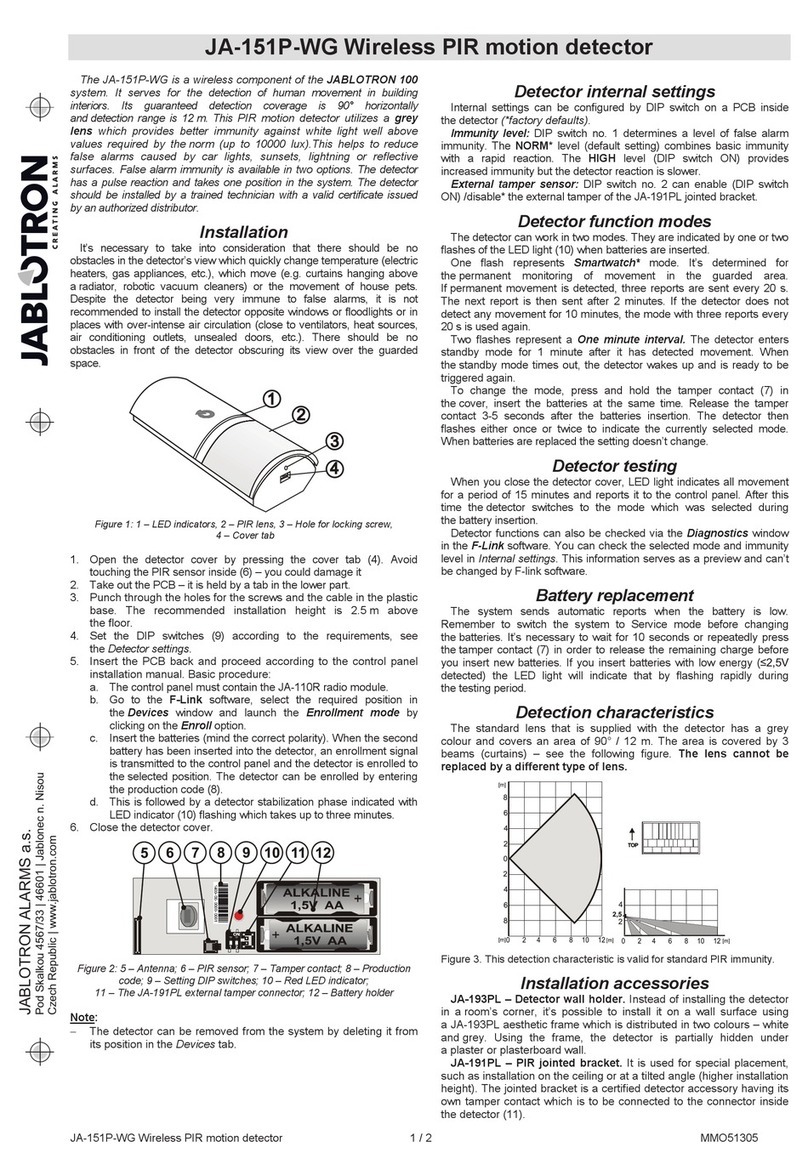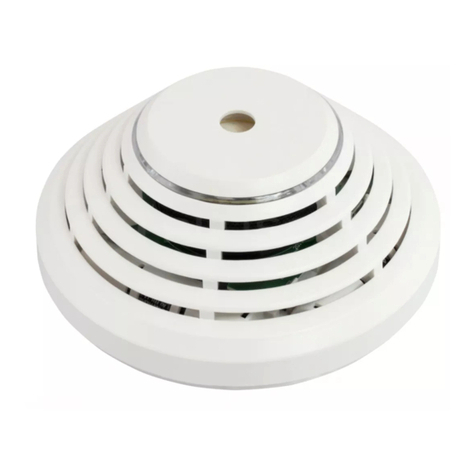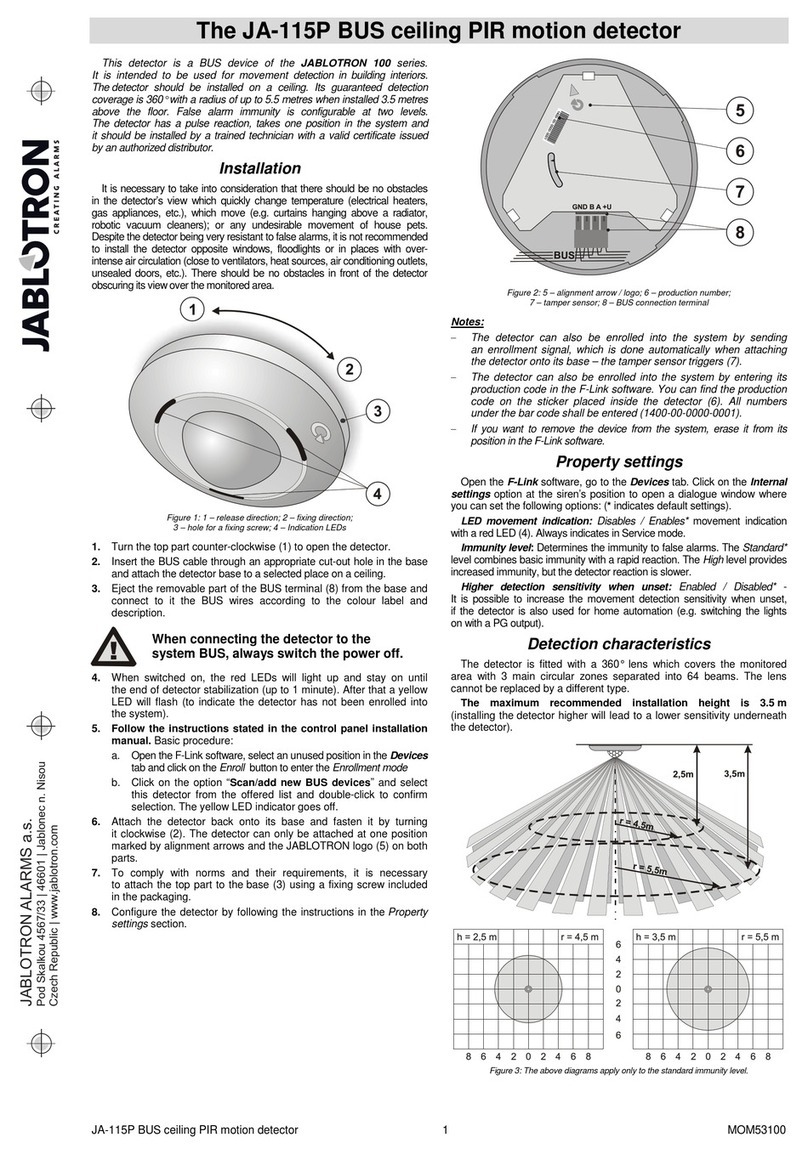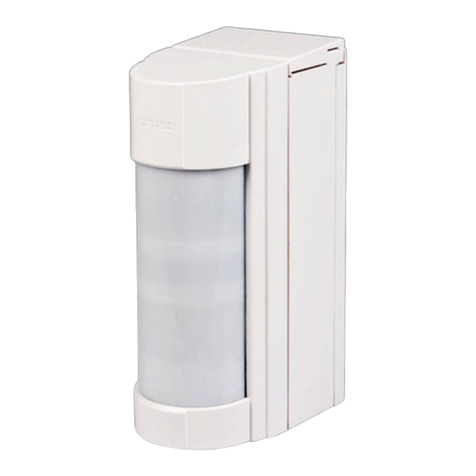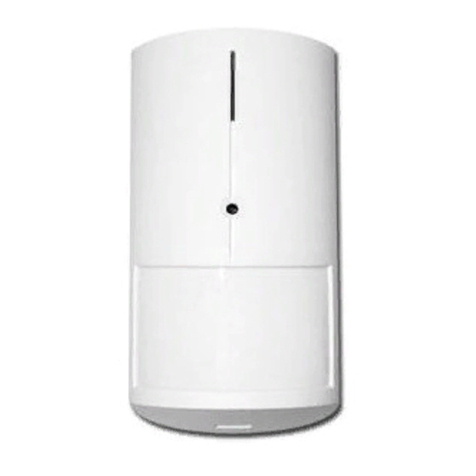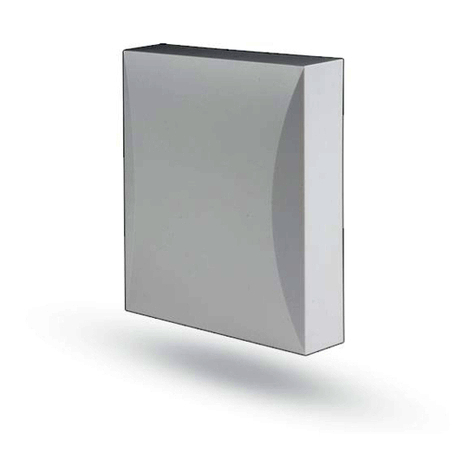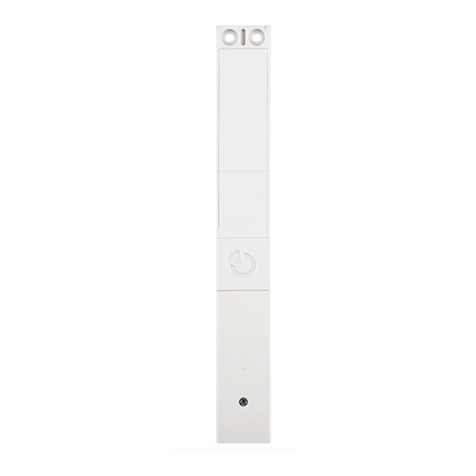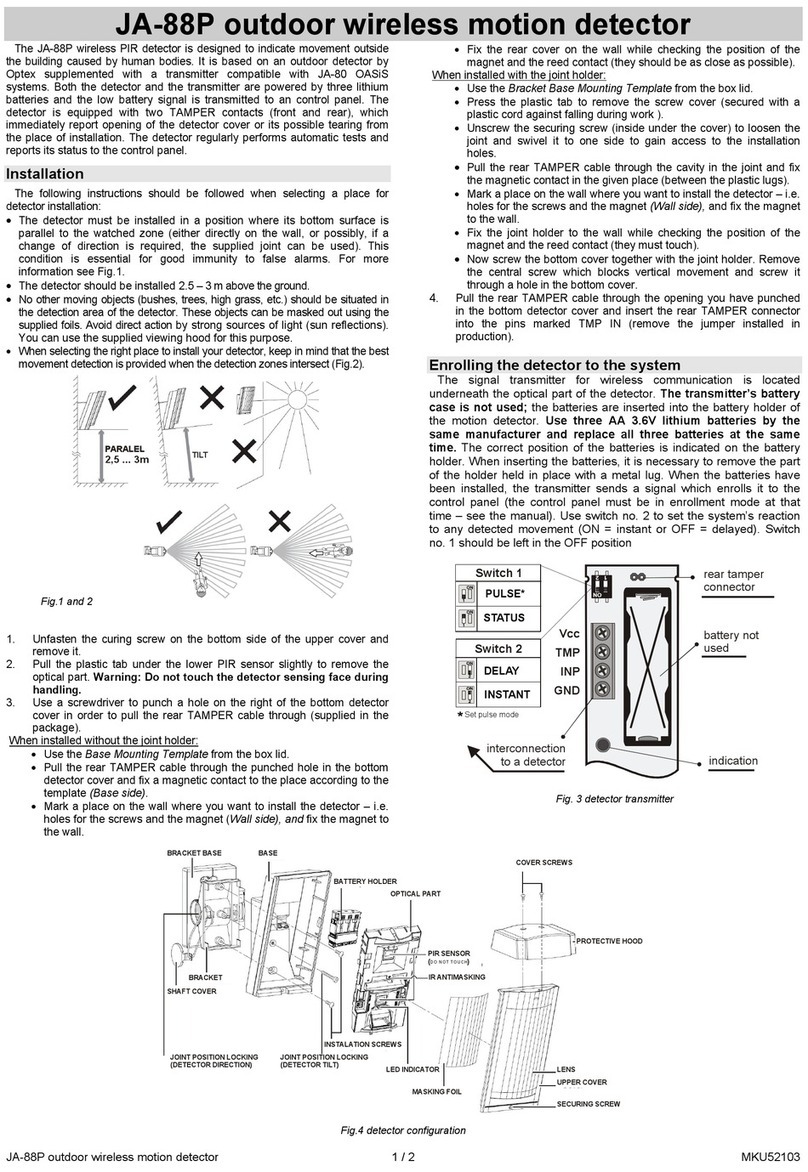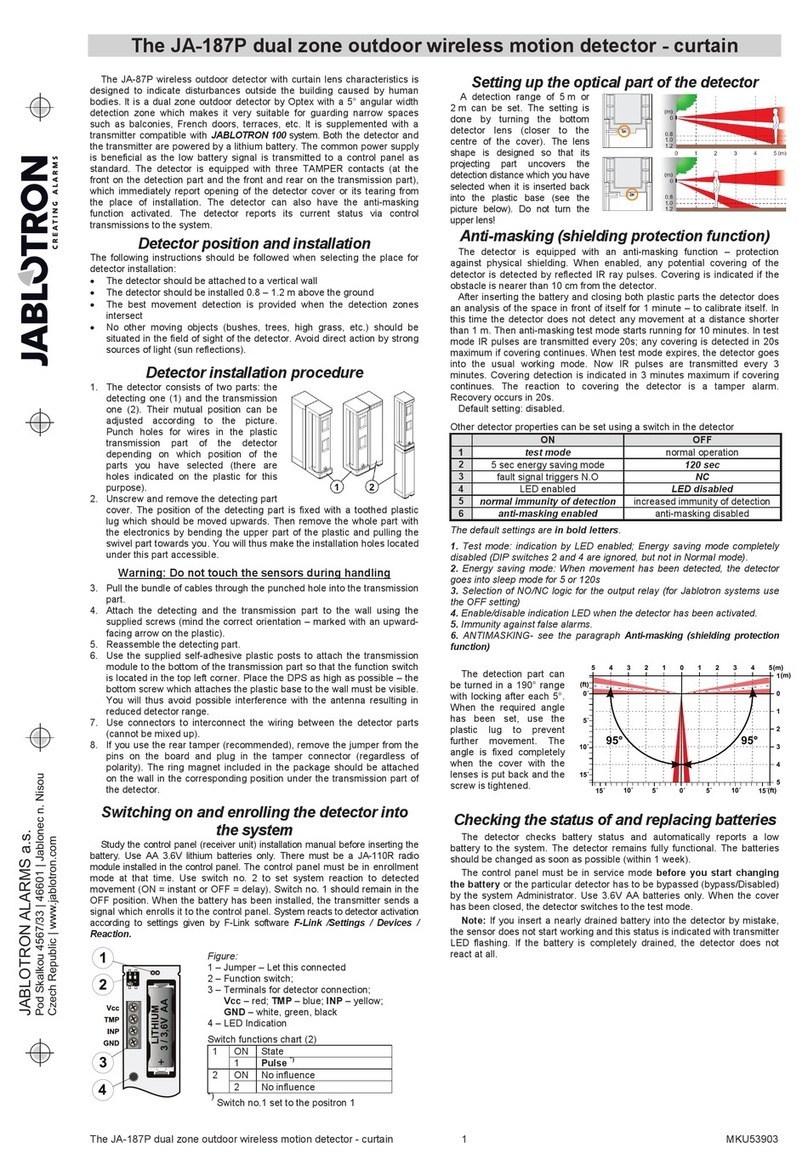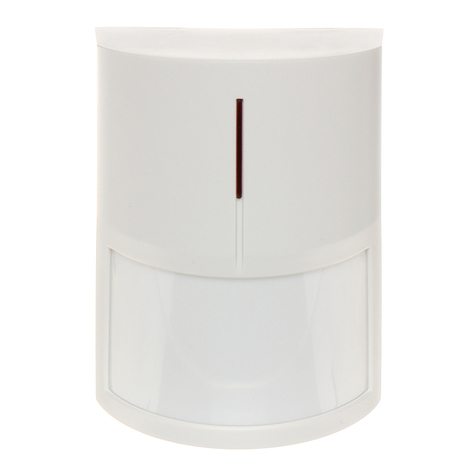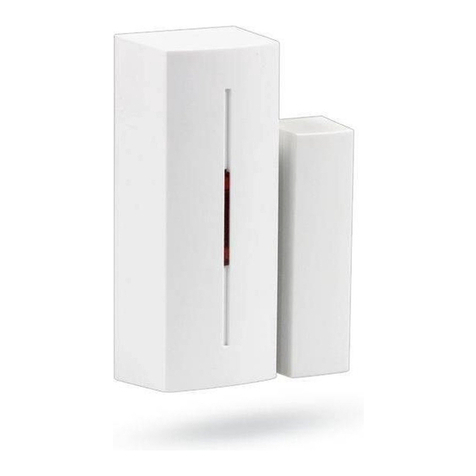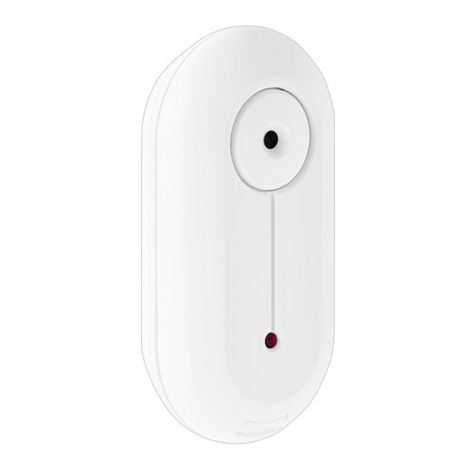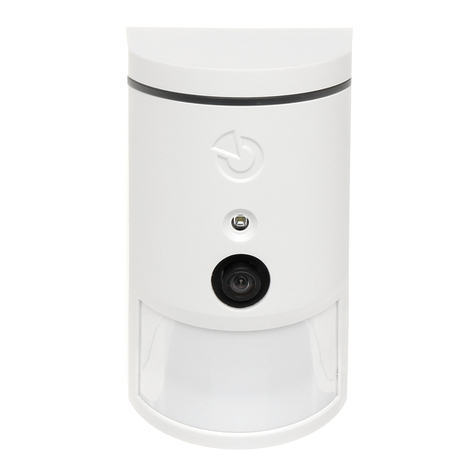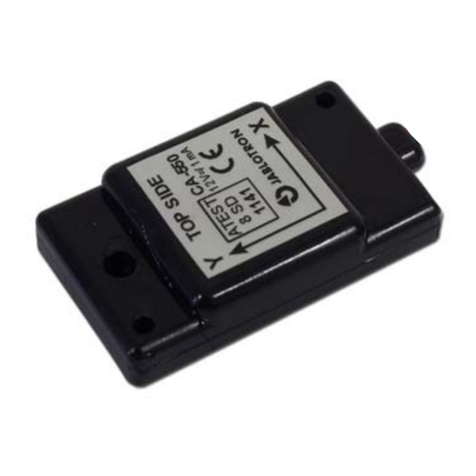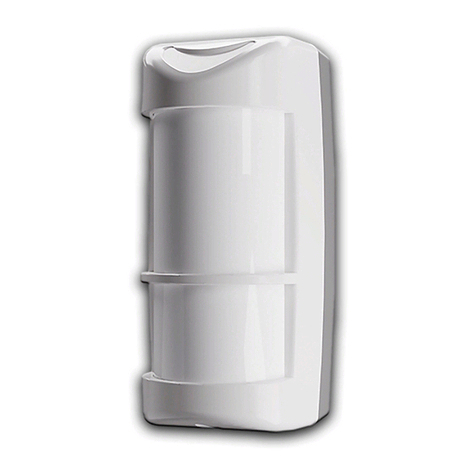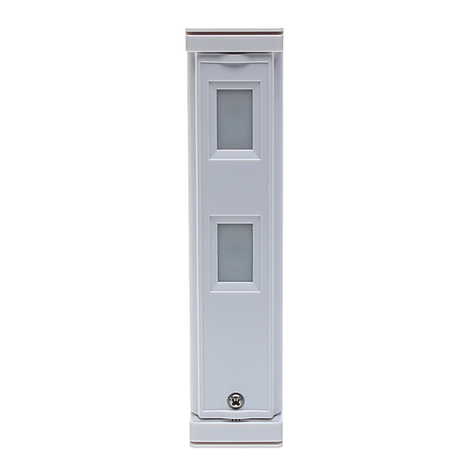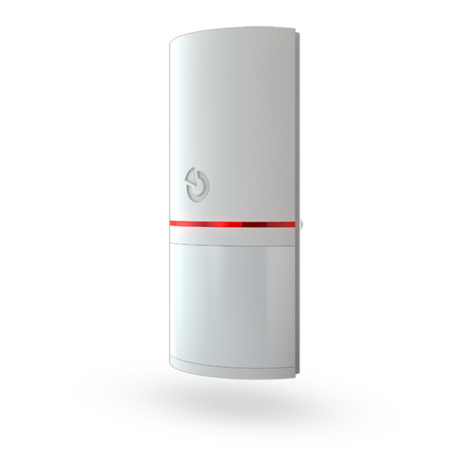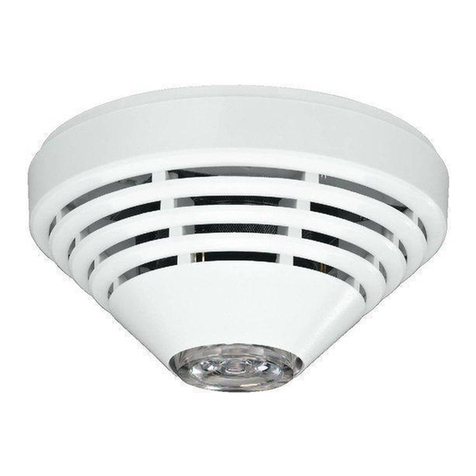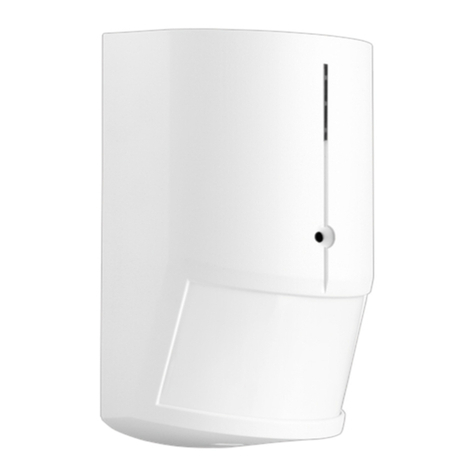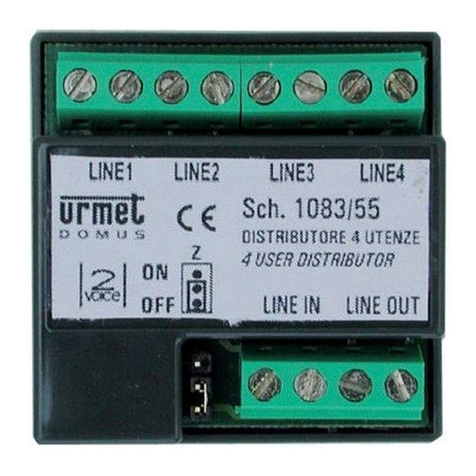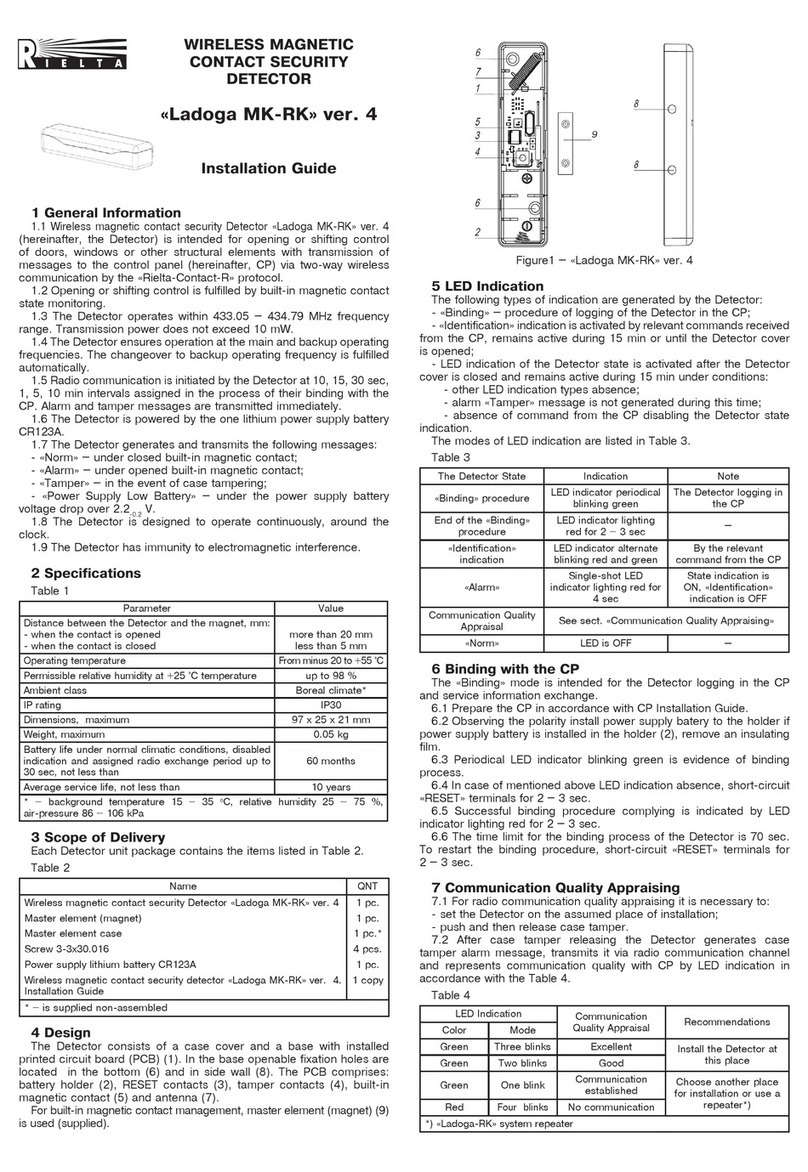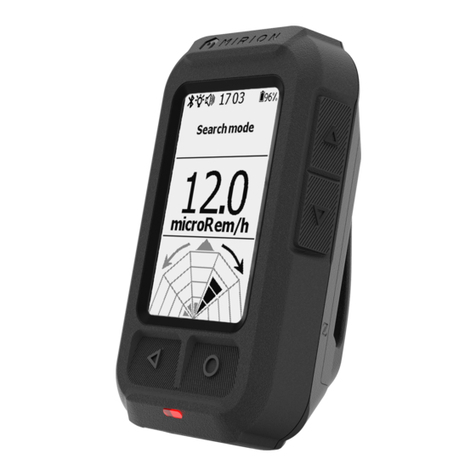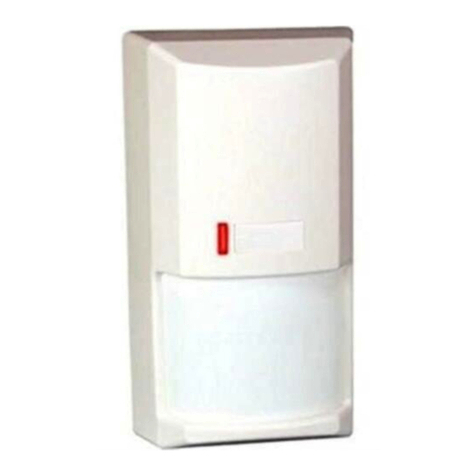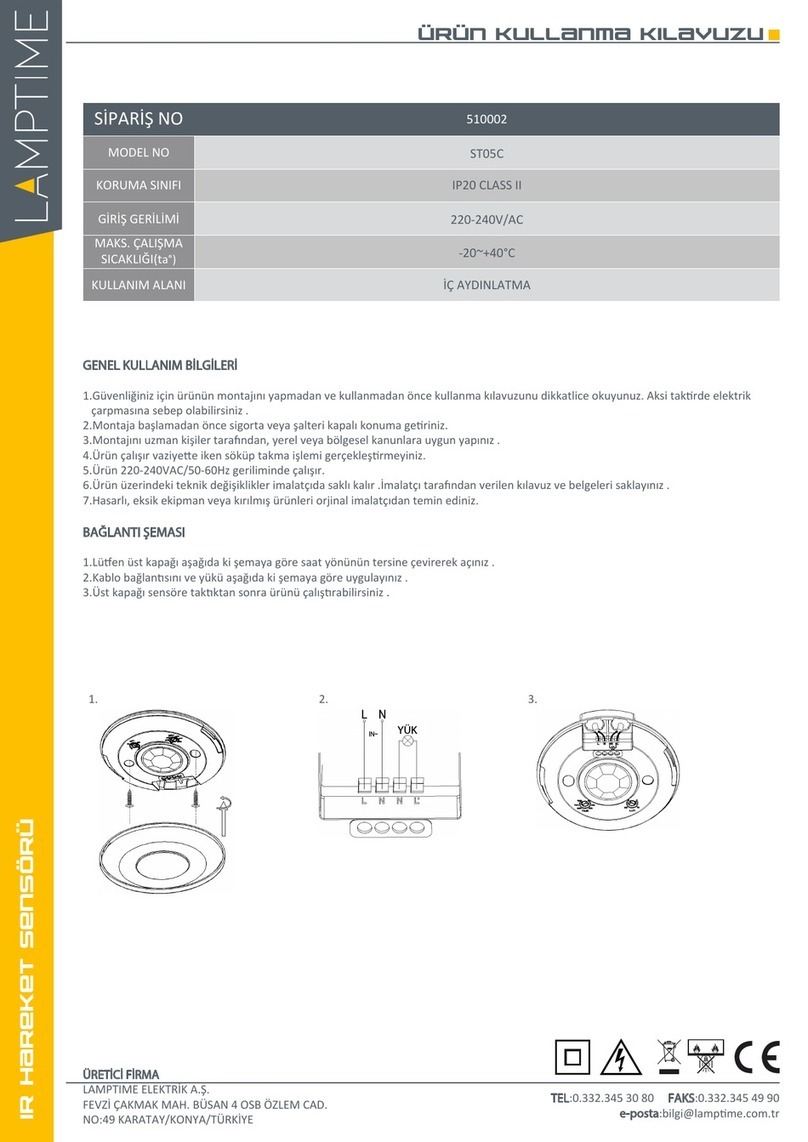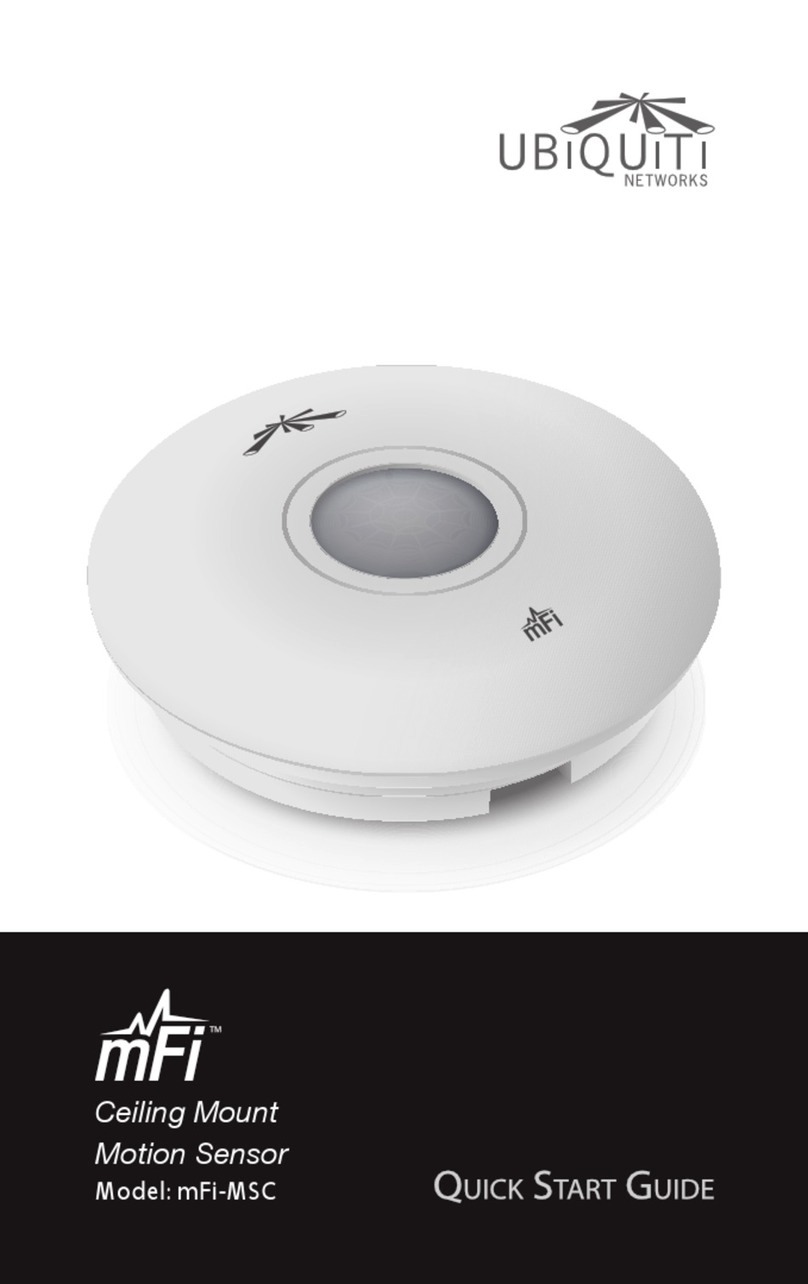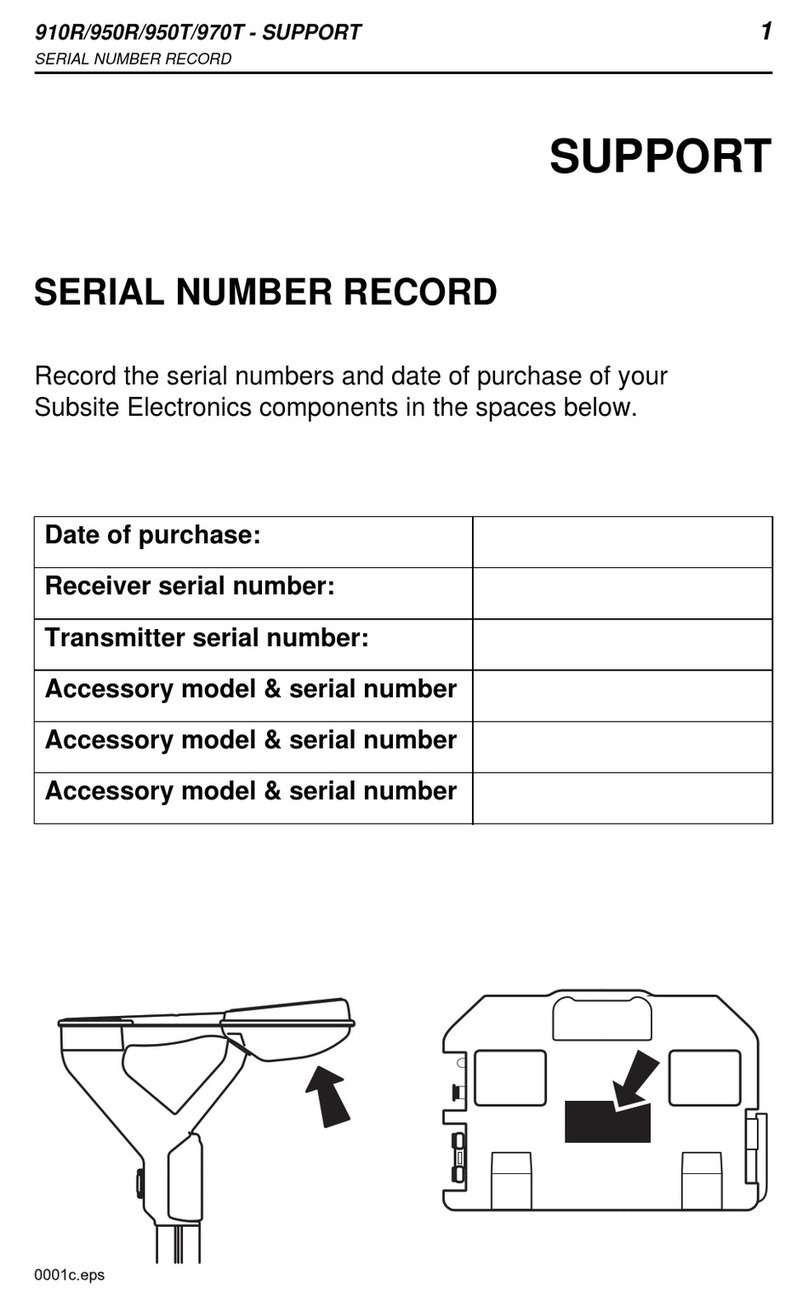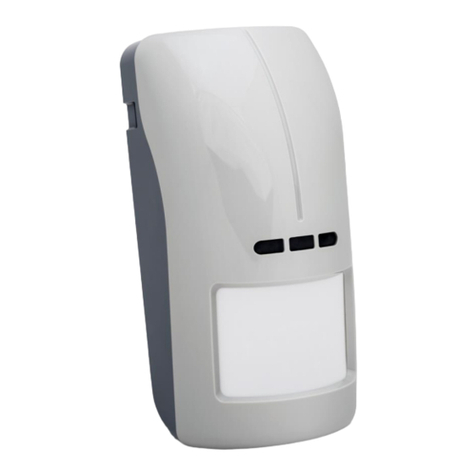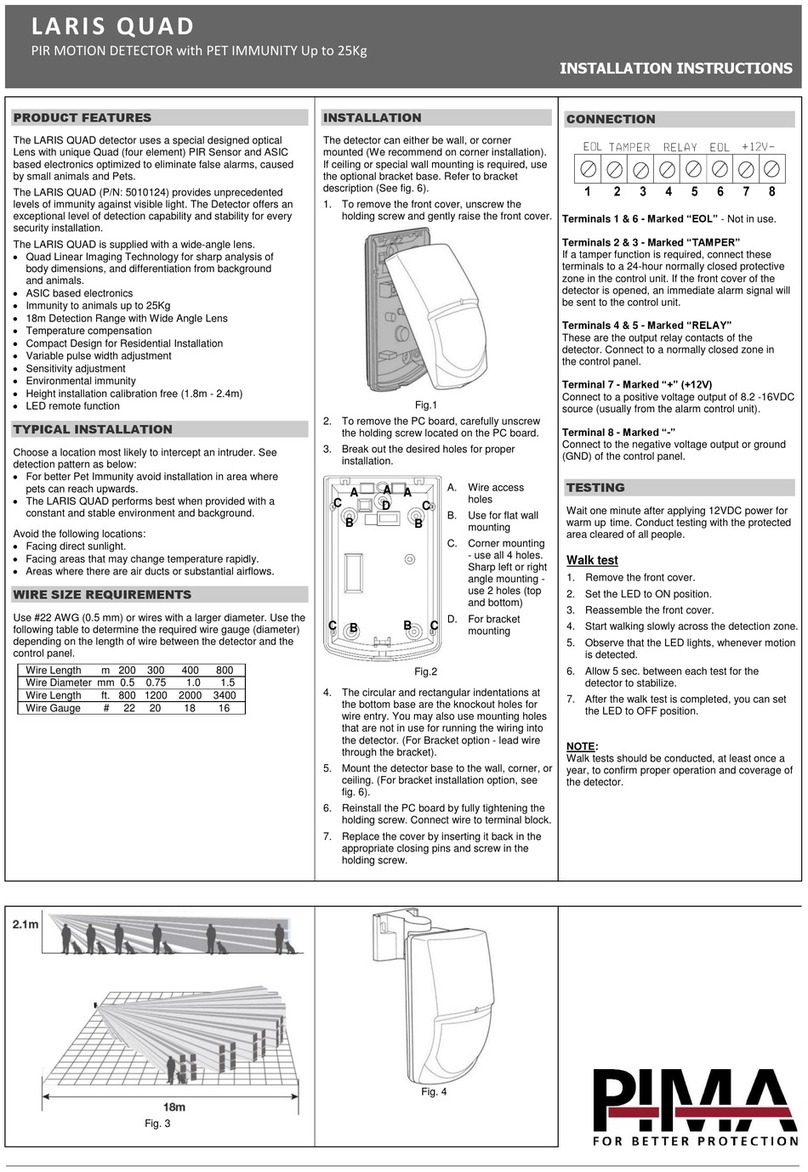
JABLOTRON ALARMS a.s.
Pod Skalkou 4567/33 46601 Jablonec n. Nisou
Czech Republic www.jablotron.com
||
|
JA-160PC Wireless PIR motion detector with a verification camera
JA-160PC Wireless PIR motion detector with a verification camera 1 / 2 MMQ51105
The JA-160PC is wireless component of the JABLOTRON 100 system.
It serves for the detection of human movement in building interiors and visual
alarm confirmation. The camera takes colour photos with a resolution of up to 640
x 480 pixels by detecting human movement while the system is set. The camera
is equipped with a visible flash for taking photos in the dark. The images are saved
in the internal memory of the detector and then they are forwarded to the control
panel. From the control panel they can be sent to MyJABLOTRON or ARC.
The detector can also take a photo on request. The detector takes one position
in the system and should be installed by a trained technician with a valid certificate
issued by an authorised distributor.
The photo-verificati
on can be used only after
the registration of the system to MyJABLOTRON
or with subsequent ARC service.
Installation
The detector can be installed onto
a wall or in the corner of a room.
There should be no obstacles which
quickly change temperature (e.g.
heating appliances,) or which move
(e.g. curtains hanging above a
radiator, robotic vacuum cleaners,
pets) in the detector´s field of sight. It
is not recommended to install the
detector opposite to windows or in
places with over-intense air
circulation (close to ventilators, heat
sources, air conditioning outlets,
unsealed doors, etc.). There should
be no obstacles in front of the
detector which might obstruct its
view of the protected area.
Figure: 1 – flash for illumination;
2 – camera lens; 3 – PIR detector
lens; 4 – cover tab;
Avoid installation too close to a ceiling. Using flash
may cause over-
exposure of the scene due
to reflections.
1. Open the detector cover by pushing the tab (4). Avoid touching the PIR
sensor inside (15) – you could damage it.
2. Take out the PCB – it is held by a tab (9).
3. The recommendedinstallation height is 2.5 m above the floor.
4. Screw the rear cover to the wall (vertically, cover tab down).
5. Re-insert the PCB and plug the connecting cable (6) into the connector
on the PCB.
Figure: 5 – Camera module; 6 – connection cable; 7 – batteries; 8 – red LED;
9 – PCB tab; 10 – yellow LED; 11 – yellow LED of Micro SD card;
12 – Micro SD memory card; 13 – mini USB connector;
14 – tamper contact; 15 – PIR sensor; 16 – production code.
6. Proceed according to the control panel installation manual. Basic procedure:
a. There must be a JA-11xR radio module installed in the control panel.
b. Go to the F-Link software, select the required position in the Devices
window and launch the enrollment mode by clicking on the Enroll option.
c. Insert the batteries (mind the correct polarity). When the second battery
has been inserted into the detector, an enrollment signal is transmitted
to the control panel and the detector is enrolled to the selected position.
This is followed by up to three-minute detector stabilization phase indicated
by the LED indicator flashing. If the discharged batteries have been
inserted the red LED indicator flashes for 3minutes.
d. If the detector is enrolled as the first PIR camera or the control panel is not
connected to MyJABLOTRON, F-link shows a dialogue window with
the question about enabling data transfer. We recommend enabling this
option with the agreement of the customer and confirming this acceptance
by recording it in the system service log with his signature.
Note: If the transmission is not enabled, photos will be saved in the internal
memory of the detector and the control panel. Then it is impossible to send
them to MyJABLOTRON and ARC.
7. Close the detector cover and test its functionality.
Notes:
- When the control panel is in service mode, the detector indicates every
movement with the red LED indicator.
- If you want to enroll the detector in the control panel after the battery has
already been inserted, remove the battery first and then press and release
the tamper contact (14) to discharge the rest of the energy and then enroll the
detector.
- The detector can be enrolled by entering the production code (16)
in the F-Link software (or a bar code reader). Enter all digits located below the
bar code (1400-00-0000-0001).
- If you want to remove the detector from the system, erase it from its position
in the control panel.
- In order to comply with the EN 50131-2-4 norm, the cover tab (4) must be
secured with the supplied screw.
Detector internal settings
Settings can be set by F-Link software in the Devices tab. Use the Internal
settings option on the detector’s position to open a dialog window where you can
configure the settings (* default settings):
PIR immunity level: Defines false alarm immunity. The *Standard level
combines basic immunity with a rapid reaction. The Increased level provides
higher immunity but the detector reaction is slower.
PG output reaction: You can select PG outputs, whose activation will trigger
taking a picture (* No, camera does not react to PG). For further info see
Installation recommendations, cautions.
Taking a photo by PG activation: No flash, *With flash
Taking photos during entrance delay: *No flash, With flash
Taking photos during alarms: No flash, *With flash
Flash intensity: Low, *Medium, High – if the captured scene is over-exposed
(e.g.in a small room), the intensity of the flash can be decreased. It can
be increased for larger spaces (this option can decrease a battery lifetime).
Increased number of photos during alarm: When enabled, 3 photos are sent
instead of 2 during each alarm event, that means more data transfer between
the detector and the control panel and between the control panel and
MyJABLOTRON or ARC. Enabling this option will decrease a battery lifetime.
This option is for specific markets so we don’t recommend enabling by default.
Send pre-alarm photos: This option is not available when the Extended LQ
photo quality is selected due to more than double size of the photo and therefore
longer transmission time. When this parameter is enabled the detector will send
photos even when the detector is configured with repeated or confirmed reaction
and the alarm has not been confirmed. During every entrance delay, up to two
photos can be taken when the detector is triggered even when the system has
been unset properly.
This option will noticeably increase the volume of data transferred
to MyJABLOTRON. If the system is not unset (alarm is triggered), the images
taken during the entrance delay will be sent automatically regardless this option.
Lithium battery operation: If the detector is tasked with frequent operation
(e.g. frequently requested photos by MyJABLOTRON) and is configured to high
flash intensity, we recommend the use of AA 1.5 V lithium batteries. If you operate
the detector from lithium batteries, this parameter must be enabled (it adjusts
detection of low batteries).
Test: takes a test photo (LQ) with a flash and F-Link displays it. When
the Detail button is pressed, the F-Link software shows the picture in a 640 x
480 px resolution. Photos are sent to MyJABLOTRON (provided that transferring
is enabled).
Camera and basic reactions
The processing of how the camera takes pictures depends on the settings
in the F-link software – Devices tab. Choose the Reaction button on a particular
detector line.
Instant: During an alarm triggered by the detector, the camera can be activated
up to 3 times (then it will be auto-bypassed). Each activation, depending
on the detected movement and settings, takes 3 photos maximum. Photos are
sent to the control panel (9 photos maximum).
Delay: The first activation (entrance delay) takes up to 2 photos according
to the detected movement and saves them into the internal memory (Send pre-
alarm image disabled). When an alarm is triggered, photos are sent from
the internal memory to the control panel. Then the behaviour is the same
as an instant reaction (11 photos maximum).
Caution:When the Device autobypass / 3rd alarm is enabled (located
in Settings/Parameters), then taking photos is blocked after the 3rd alarm. During
each alarm the detector can be triggered up to three times. This way, the number
of taken and transferred photos can be tripled (18/24 photos). Applies
to Instant / Delayed reactions.
